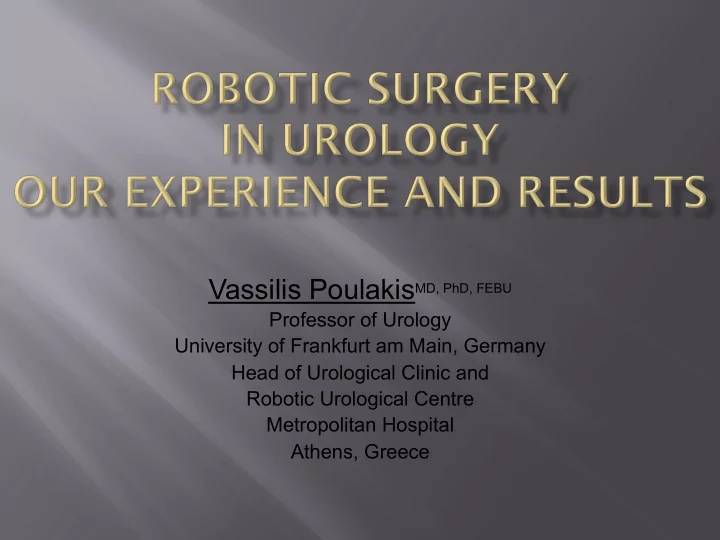

Vassilis Poulakis MD, PhD, FEBU Professor of Urology University of Frankfurt am Main, Germany Head of Urological Clinic and Robotic Urological Centre Metropolitan Hospital Athens, Greece
In 2000, the first application of robotic surgery in a case of § prostate cancer in the Urological Clinic of University of Frankfurt, Germany Since then, robotic surgery in Urology has § § gained massive ground § established as the ‘’gold standard’’ technique for the majority of urological conditions, both benign and malignant Since 2006, § § I came back in Greece § I organized the Robotic Urological Centre § I have successfully performed over 7.000 robotic surgeries, involving all malignancies of kidney, ureter, bladder and prostate, as well as benign urological cases such as bladder diverticulum, benign prostate hyperplasia, ureteric strictures etc.
Since 2006, over 4.500 successful cases § Patients having various stages of prostate cancer, from cT1 to cT3b with § locally advanced disease Within a follow-up schedule at 6 months, 1 year and 2 yrs, functional § outcomes such as erectile function and continence were comparable and in many cases better than those presented in open series. Especially in low and medium risk cases, were preservation of § neurovascular bundles was oncologically safe, continence and erectile function rates reach almost 95% Oncological outcomes at 1,5, and 10 yrs were comparable and similar § even better to open and laparoscopic series, based on large multicentral retrospective studies comparing robotic to open surgery Extended lymphadenectomy performed according to nomograms (mean: § 29, range: 18-96 nodes) Multi-parametric MRI of the prostate and fusion biopsy in order to detect § significant cancer sites that traditional TRUS-biopsy usually misses In conclusion, robotic radical prostatectomy is the ‘’gold standard’’ method § of surgery in many countries including USA, where over 90% of prostate cancer cases are treated robotically
Successfull performance of approximately 700 robotic radical ¨ cystectomy surgeries All kinds of urinary diversion techniques are applied ¨ intracorporeally (ileal conduit and orhotopic Studer neobladder) depending on pre-surgical evaluation. Oncological results in 1 and 5 yrs follow-up are similar with open ¨ surgery series. Functional outcomes in cases of Studer neobladder in terms of ¨ continence and potency are superior to open surgery (more than 80% continence and over 95% potency) Surgical morbidity and complication rates, length of hospital stay, ¨ are significantly lower with robotic surgery
¨ Nephro-Ureterectomy is the surgical treatment for urothelial tumors of kidney and ureter ¨ We have performed approximately 400 robotic surgeries ¨ Surgical morbidity, in-hospital stay, post- surgical complication rates were significantly lower compared to open and laparoscopic surgery. ¨ Oncological outcomes at 1 and 5 yrs follow-up are similar to open surgery series.
Radical nephrectomy is the treatment of choice for kidney ¨ tumors more than 7 cm in size (>T2) or tumors located near the renal hilum or for large totally endophytic tumors. Tumor size ranges from 2,5 (intrarenal-hilar) to 21cm ¨ Including cava thrombus reached just below the hepatic veins ¨ Patient with BMI over 40 kg/m 2 ¨ Robotic radical nephrectomy has become the ‘’gold standard’’ ¨ treatment for those kidney tumors. Over 800 robotic radical nephrectomy surgeries ¨ All parameters, including hospital length stay, blood loss, post ¨ surgical complication rates, are much lower compared to open and laparoscopic surgery.
Partial nephrectomy is the treatment of choice for small, T1 renal ¨ tumors. Even in open surgery, partial nephrectomy is a technically challenging method. As it applies for radical nephrectomy, robotic partial nephrectomy ¨ has also become the ‘’gold standard’’ treatment of choice. Performed over 700 robotic cases ¨ In selected cases, non-clamping method was also used ¨ Challenging cases with Padua score over 10 in 40% of the cases ¨ Intracorporeal/Robotic-Guided Ultrasound devise is using ¨ In our series, positive surgical margin rates were lower compared to ¨ open surgery, almost 0% (one case, 1/700) In 5 yrs follow up, oncological results similar to open surgery series ¨ Although robotic partial nephrectomy presents many advantages ¨ compared with open surgery, it still remains a challenging technique even for experienced robotic surgeons
Robotic surgery is the present and future in Urology ¨ Our clinic in Metropolitan hospital is provided with the latest two da ¨ Vinci surgical systems, Xi and Si. In most cases, robotic surgery is the ‘’gold standard’’ technique for all ¨ malignancies and benign conditions of the genitourinary tract. The advantages from the use of the robotic system are various: ¨ ¡ 15x magnification of the surgery field ¡ Three-dimensional view ¡ No hand tremor, with precise movement of the robotic arms ¡ Robotic arm mimics the wrist movements, with 8 degrees of freedom But the most important thing is the experience ! ¨ ¡ Because robotic surgery is a useful tool, at the hands of an experienced surgeon , who is able to utilize all the advantages of the new technique, the optimal results for the patients are guaranteed!
Recommend
More recommend